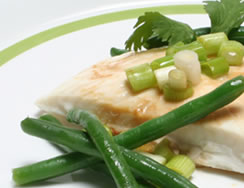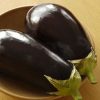Fruit is more than a snack or dessert. The flavor and nutritional value of many savory dishes can be enhanced by adding fruit.
Adding fruit to non-sweet dishes is common in Southeast Asia, where it contributes the sweet element in the hot-sour-salty-bitter-sweet balance cooks strive for.
Vietnamese fish soup, for example, often includes pineapple along with tomatoes and bean sprouts. Thai versions of stir-fried rice also use pineapple. And fruit is a key feature in Chinese sweet-and-sour dishes.
Fruit gives a dish a different flavor and texture. Bosc or Asian pears as well as apples add a delicate sweetness and crunch. Pineapple, berries, grapes, oranges and grapefruit provide a tangy, citrus taste. And mangos, plums, persimmons, peaches and nectarines add a rich, mellow flavor and an additional, silky layer of texture.
Fruit is an important part of a healthful diet. The American Institute for Cancer Research recommends that your plate hold two-thirds (or more) of fruits, vegetables, whole grains and beans, and one-third (or less) of animal meats. Southeast Asian dishes generally conform to these proportions.
A largely plant-based diet supplies more phytochemicals (natural substances found only in plant foods) than one in which animal proteins predominate. Studies show that diets high in fruits and vegetables protect against many different types of cancer. Scientists believe phytochemicals protect the body's cells from damage by cancer-causing agents.
The addition of fruit to entrees and other savory dishes is a step in the right direction. A salad is a good place to start experimenting.
The sweetness and juiciness of strawberries, for example, is a perfect contrast to the slight bitterness of spinach and romaine lettuce. Strawberries, spinach and romaine not only taste great together, but offer a bowl full of nutrition. Strawberries are rich sources of vitamin C, dietary fiber and the phytochemical ellagic acid also found in cranberries and raspberries.
Dark, leafy green vegetables like spinach and Romaine lettuce are rich in other important phytochemicals that help prevent different diseases, including macular degeneration. The following salad is in AICR's cookbook, The New American Plate Cookbook: Recipes for a Healthy Weight and a Healthy Life.
Spinach, Romaine and Strawberries with Balsamic Vinaigrette
Makes 6 servings.
Ingredients
- Leaves of 1 head romaine lettuce, torn in bite-sized pieces
- 6 oz. fresh spinach leaves, torn in bite-sized pieces
- 2 cups fresh strawberries, hulled and quartered
- 1/4 cup loosely-packed, coarsely-chopped flat-leaf parsley
- 1 Tbsp. balsamic vinegar, or to taste
- 2 Tbsp. extra-virgin olive oil
- Salt and freshly ground pepper
Directions
- In a large bowl, toss together the lettuce, spinach and strawberries, or arrange them on 6 individual plates. Sprinkle the parsley on top.
- Whisk vinegar and olive oil in a small bowl to blend. Drizzle the dressing over the salad. Season salad to taste with salt and pepper and serve immediately.
Nutritional Information Per Serving:
62 calories,
5 g. total fat (less than 1 g. saturated fat),
4 g. carbohydrate,
1 g. protein,
2 g. dietary fiber, 23 mg. sodium
Diabetic Exchanges: 1 Vegetable, 1/2 Fruit, 1 Fat
AICR








